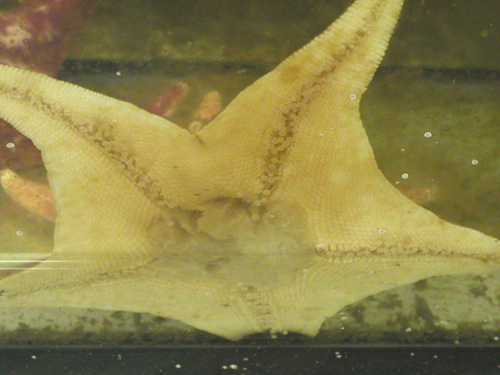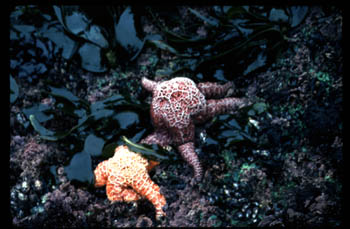| MadSci Network: Zoology |
Hi Elyse,
Seastars (the preferred term, as these animals aren't fish at all) are predators or scavengers. Some of them are capable of attacking and killing prey and all will, to some extent, scavenge on things that are already dead. A few will even feed on algal films.
Now, to address the more interesting part of your question: the question about HOW seastars feed. I'm going to use the ochre star, Pisaster ochraceus, as an example. Seastars have two stomachs, one of which can be everted out of the animal's mouth. When scavenging on dead things, the star can simply plop out its stomach onto the food. Digestive enzymes go to work on the food, and the resulting slurry is slurped up as the stomach is retracted back into the star's body. This morning I took a photo of a seastar that had everted its stomach onto the algal film growing on the side of its tank. The frilly structure in the center of the animal's body is the everted stomach:

Pisaster, which is an active predator, loves to eat mussels. The trick to eating a mussel is getting the mussel's shells open. If you've ever tried to do this, you know it's not an easy feat. Pisaster, however, is well-equipped to break into its prey. As members of the Class Asteroidea within the Phylum Echinodermata, seastars have an internal hydraulic water vascular system that you can see in the photo above as five radiating rows of suckered tube feet on the oral surface of the animal. Pisaster uses the combined force of hundreds of tube feet to pry open a mussel, which in turn is using its own adductor muscles to hold its shells closed. If the star can open a mussel's shells just a millimeter or so, it can slip its stomach inside and digest the prey within its own protective shells. Along rocky shores of the west coast of North America, you will often find a Pisaster humped up in a mussel bed; this animal will most likely be involved in a tug-of-war with its prospective prey. Here's a photo of Pisaster in action:

I hope this answers your question. For additional information and photos on Pisaster on west coast rocky shores, here's a good site. The Pisaster info is about halfway down the page, but you'll run into some other cool stuff on your way to it. And by the way, this site is where I found the photo of Pisaster feeding.
Allison J. Gong
Try the links in the MadSci Library for more information on Zoology.